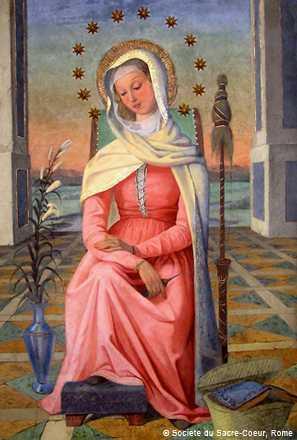
The following is from Sister Pauline Perdrau's recollection of her experience painting Mater Admirabilis at the Trinita dei Monti in Rome.
On Sunday, May 1, 1844, the Community (I was at this time a postulant at the Trinita dei Monti in Rome) was assembled for recreation in the cloister in one of the long cloisters of the quadrangle opening on the courtyard of the old Monastery of the Minims … Reverend Mother was called to see a Cardinal. All exclaimed as she rose, “Oh, if the Blessed Virgin would only come and take our Mother’s place.” My glance was directed by inspiration towards a niche in the opposite wall … At the same time I recalled the Madonna of the Temple, my childhood’s ideal. “Shall I ask Our Lady to come? Shall I place her where she can stay and work with us?”
I had studied art, especially fresco painting … I began my picture. I shall not say how easy it was to trace the outline of the picture so long stamped on my mind and heart. My pencil seemed to have wings … My only aid became the mason sent to cover the wall with fresh lime every morning. On this I had to paint while it was still fresh, or rather damp….
On the 22nd of June, 1844, Feast of Our Lady of Peace, I finished the face of my dear Madonna. From 6:00 A.M. to 7:00 P.M., I worked on that sweet, pure face, the wall remaining perfect all the time. Our Lady is helping me, I thought, but I spoke to no one of my secret … I could easily understand the mistrust that the unfinished picture inspired. It presented a most doleful appearance … I was almost horrified at the sight, and asked permission to hang a curtain before the niche. Having done this, I continued to work in solitude . . .
… The Blessed Virgin was the artist at the Trinita, and I have never felt the same kind of assistance since …
(This commentary was added to Mother Perdrau’s account and published in the Messenger of the Sacred Heart, October 1899. The picture of Mater Admirabilis is now classed among the miraculous images of our Blessed Lady. The wall surrounding the fresco is covered with ex-votos (offerings), while the fresco itself has been pierced in order that our Mother may be adorned with a crown and necklace.
Shortly after the artist finished her labor of love, His Holiness, Pius IX, came to the Trinita. Until his coming, the picture had been called the Virgin of the Temple, or the Madonna of the Lily, but when our Holy Father knelt in prayer before it, he cried out in admiration, “She is truly Mater Admirabilis,” and so this image has been called that ever since.)



